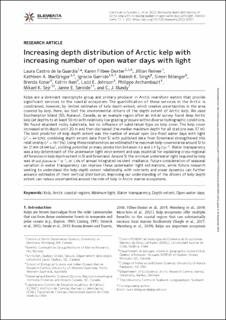| dc.contributor.author | Castro de la Guardia, Laura | |
| dc.contributor.author | Filbee-Dexter, Karen | |
| dc.contributor.author | Reimer, Jillian | |
| dc.contributor.author | MacGregor, Kathleen A. | |
| dc.contributor.author | Garrido, Ignacio | |
| dc.contributor.author | Singh, Rakesh K. | |
| dc.contributor.author | Bélanger, Simon | |
| dc.contributor.author | Konar, Brenda | |
| dc.contributor.author | Iken, Katrin | |
| dc.contributor.author | Johnson, Ladd E. | |
| dc.contributor.author | Archambault, Philippe | |
| dc.contributor.author | Sejr, Mikael K. | |
| dc.contributor.author | Søreide, Janne | |
| dc.contributor.author | Mundy, C.J. | |
| dc.date.accessioned | 2023-09-21T11:43:47Z | |
| dc.date.available | 2023-09-21T11:43:47Z | |
| dc.date.created | 2023-01-31T16:19:23Z | |
| dc.date.issued | 2023 | |
| dc.identifier.citation | Elementa: Science of the Anthropocene. 2023, 11 (1), . | |
| dc.identifier.issn | 2325-1026 | |
| dc.identifier.uri | https://hdl.handle.net/11250/3091073 | |
| dc.description.abstract | Kelps are a dominant macrophyte group and primary producer in Arctic nearshore waters that provide significant services to the coastal ecosystem. The quantification of these services in the Arctic is constrained, however, by limited estimates of kelp depth extent, which creates uncertainties in the area covered by kelp. Here, we test the environmental drivers of the depth extent of Arctic kelp. We used Southampton Island (SI), Nunavut, Canada, as an example region after an initial survey found deep Arctic kelp (at depths to at least 50 m) with relatively low grazing pressure within diverse hydrographic conditions. We found abundant rocky substrata, but no influence of substratum type on kelp cover. The kelp cover increased with depth until 20 m and then decreased (the median maximum depth for all stations was 37 m). The best predictor of kelp depth extent was the number of annual open (ice-free) water days with light (r2 = 44–52%); combining depth extent data from SI with published data from Greenland strengthened this relationship (r2 = 58–71%). Using these relationships we estimated the maximum kelp-covered area around SI to be 27,000–28,000 km2, yielding potential primary production between 0.6 and 1.9 Tg Cyr−1. Water transparency was a key determinant of the underwater light environment and was essential for explaining cross-regional differences in kelp depth extent in SI and Greenland. Around SI the minimum underwater light required by kelp was 49 mol photons m−2 yr−1, or 1.4% of annual integrated incident irradiance. Future consideration of seasonal variation in water transparency can improve these underwater light estimations, while future research seeking to understand the kelp depth extent relationship with nutrients and ocean dynamics can further advance estimates of their vertical distribution. Improving our understanding of the drivers of kelp depth extent can reduce uncertainties around the role of kelp in Arctic marine ecosystems. | |
| dc.language.iso | eng | |
| dc.title | Increasing depth distribution of Arctic kelp with increasing number of open water days with light | |
| dc.title.alternative | Increasing depth distribution of Arctic kelp with increasing number of open water days with light | |
| dc.type | Peer reviewed | |
| dc.type | Journal article | |
| dc.description.version | publishedVersion | |
| dc.source.pagenumber | 20 | |
| dc.source.volume | 11 | |
| dc.source.journal | Elementa: Science of the Anthropocene | |
| dc.source.issue | 1 | |
| dc.identifier.doi | 10.1525/elementa.2022.00051 | |
| dc.identifier.cristin | 2120628 | |
| dc.relation.project | Norges forskningsråd: 296836 | |
| cristin.ispublished | true | |
| cristin.fulltext | original | |
| cristin.qualitycode | 1 | |
